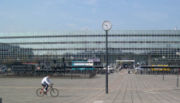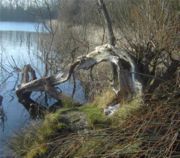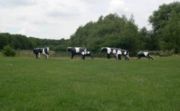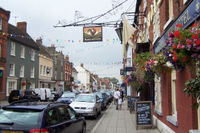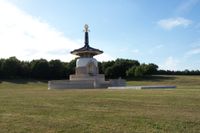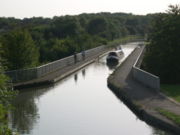Milton Keynes
2007 Schools Wikipedia Selection. Related subjects: Geography of Great Britain
Milton Keynes [ˌmɪltənˈkiːnz] is a large town in northern Buckinghamshire, in South East England, about 45 miles/75 km north-west of London, and roughly halfway between London and Birmingham. Milton Keynes was formally designated as a new town in January 1967. Its 34 square miles (88km²) area incorporated the existing towns of Bletchley, Wolverton and Stony Stratford along with another fifteen villages and farmland in between. It took its name from the existing village of Milton Keynes, a few miles east of the planned city centre. Uniquely for the UK, the urban form uses a 1km grid for the top level of street hierarchy: the local form of most districts is more conventional.
At the 2001 census the population of the Milton Keynes urban area, also including the town of Newport Pagnell, was 184,506, and that of the wider borough of Milton Keynes, which has been a unitary authority independent of Buckinghamshire since 1997, was 207,063 (compared to a population of around 53,000 for the same area in 1961)
| Milton Keynes | ||
|---|---|---|
|
|
||
| Statistics | ||
| Population: | 184,506 | |
| Ordnance Survey | ||
| OS grid reference: | SP852387 | |
| Administration | ||
| Borough: | Milton Keynes | |
| Region: | South East England | |
| Constituent country: | England | |
| Sovereign state: | United Kingdom | |
| Other | ||
| Ceremonial county: | Buckinghamshire | |
| Historic county: | Buckinghamshire | |
| Services | ||
| Police force: | Thames Valley | |
| Fire and rescue: | {{{Fire}}} | |
| Ambulance: | South Central | |
| Post office and telephone | ||
| Post town: | MILTON KEYNES | |
| Postal district: | MK1 - 15 | |
| Dialling code: | 01908 | |
| Politics | ||
| UK Parliament: | North East Milton Keynes Milton Keynes South West |
|
| European Parliament: | South East England | |
History
A new city
In the 1960s, the Government decided that a further generation of new towns in the South East was needed to relieve housing congestion in London.
Since the 1950s, overspill housing for several London boroughs had been constructed in Bletchley. Further studies in the 1960s identified north Buckinghamshire as a possible site for a large new town, a new city, encompassing the existing towns of Bletchley, Stony Stratford and Wolverton. The New Town (informally, "New City") was to be the biggest yet, with a target population of 250,000. The designated area was 25,200 acres/10,200 hectares. The name "Milton Keynes" was taken from the existing village of Milton Keynes on the site.
The site was deliberately located equidistant from London, Birmingham, Leicester, Oxford and Cambridge with the intention that it would be self-sustaining and eventually become a major regional centre in its own right. Planning control was taken from elected local authorities and delegated to the Milton Keynes Development Corporation (MKDC).
The Corporation's strongly modernist designs featured regularly in the magazines Architectural Design and the Architects' Journal. MKDC was determined to learn from the mistakes made in the earlier New Towns and revisit the Garden City ideals. They set in place the characteristic grid roads that run between districts and the intensive planting, lakes and parkland that are so appreciated today.
The Government wound up MKDC in 1992, transferring control to the Commission for New Towns (CNT) and then finally to English Partnerships, with the planning function returning to local authority control (since 1974 and the Local Government Act 1972, the Milton Keynes Borough Council, which was subsequently made a unitary authority in the 1990s). Most recently, the Government has assigned significant planning control to English Partnerships, charging it with increasing the population beyond to 300,000 by 2030.
The borough applied for formal city status in the 2000 and 2002 competitions, but was not successful.
Prior history
The area that was to become the New City encompassed a landscape that has a rich historic legacy. Evidence of permanent settlement dates back to the Bronze Age. The area to be developed was largely farmland and undeveloped villages. Before construction began, every area was subject to detailed archaeological investigation: doing so has provided a unique insight into the history of a large sample of the landscape of south-central England. When the boundary of Milton Keynes was defined, some 40,000 people lived in the "designated area" of 8,851 ha/21,833 a. Collections of oral history covering the 20th century completes a picture that is described in detail at the article History of Milton Keynes.
Urban design
Grid squares
Milton Keynes Development Corporation planned the city's layout according to street hierarchy principles, using a grid pattern of approximately 1 km interval, rather than on the more conventional radial pattern found in older settlements. Major roads within the city run between communities, rather than through them: the major roads are known locally as grid roads and the spaces between them are known as grid squares. Intervals of 1 km were chosen so that people would always be within walking distance of a bus stop (buses were originally intended to run only on the grid but this has not happened — buses take tortuous routes through the grid squares). Consequently each grid square is a semi-autonomous community, making a unique collective of 100 clearly identifiable neighbourhoods within the overall urban environment. The grid squares have a variety of development styles, ranging from conventional urban development and industrial parks to original rural and modern urban and pseudo-rural developments.
Roads
Roundabout junctions were built at intersections since the grid roads were intended to carry large volumes of traffic: this type of junction is efficient at dealing with these volumes. Along the edges of each grid road there are large grassed areas, known as 'reservations'. This is deliberate and allows roads to be upgraded from single carriageway to become dual carriageways as traffic volumes dictate. The edges of each grid square are heavily landscaped and some are banked up and densely planted. The purpose of this was to reduce traffic noise for residents but traffic noise is still significant at some locations. Traffic movements are fast, with little congestion since there are many alternative routes to a particular destination. The national speed limit applies on dualled sections of the grid roads (70 mph) and most single carriageway grid roads (60 mph), although some single carriageway speed limits have now been reduced to 40 mph. Consequently the risk to unwary pedestrians and turning traffic is significant, although pedestrians rarely have to cross grid roads at grade, as underpasses exist in several places along each stretch of all of the grid roads. Monitoring station data shows that pollution is lower than in other settlements of a similar size. This can be partially attributed to the large number of trees, particularly to the fact that trees line grid roads in most places.
Height
The original design guidance for the city declared that "no building [be] taller than the tallest tree". However, the Milton Keynes Partnership, in its expansion plans for Milton Keynes, believes that Central Milton Keynes (and elsewhere) needs "landmark buildings" and has recently lifted the height restriction for the area. As a result, 14- storey buildings are now being built in the town centre.
Linear parks
The flood plains of the Great Ouse and of its tributaries (the Ouzel and some brooks) have been protected as linear parks that run right through the city. The Grand Union Canal is another green route (and demonstrates the level topology of the city - there is just one minor lock in its entire 10 mile route through from Fenny Stratford to the "Iron Trunk" Aqueduct at Wolverton. The Milton Keynes redway system of cycleways and footpaths uses these and other routes.
"City in the forest"
The original Development Corporation design concept aimed for a "forest city" and its foresters planted millions of trees from its own nursery in Newlands in the following years. As of 2006, the urban area has 20 million trees.
Further development plans
In January 2004, Deputy Prime Minister John Prescott announced the Government's plan to double the population of Milton Keynes by 2025. He appointed English Partnerships to do so, taking planning controls away from Milton Keynes Borough Council and making EP the statutory planning authority. Their proposal for the next phase of expansion moves away from grid squares to large scale, mixed use, higher density development. The more detailed article expands on the details of their proposals.
As might be anticipated, these plans are controversial — especially as planning control has been removed again from elected local authorities and placed in a central-government appointed body.
Milton Keynes is at the centre of the South Midlands area identified by the government for growth.
Culture
The open air National Bowl is a 65,000 "seat" venue for large scale rock (and classical) concerts. It is situated off the A5 near Furzton.
The 1,400-seat Milton Keynes Theatre (Blonski-Heard) opened in 1999. Its high booking rate allows it to lay claim to the title "Britain's most popular theatre". The theatre has a unusual feature: the ceiling can be lowered closing off the third tier (gallery) to create a more intimate space for smaller scale productions. There are further performance spaces in Bletchley, Leadenhall, Shenley Church End, Stantonbury and Walton Hall.
The the municipal (art) gallery (Milton Keynes Gallery, next to the main theatre) hosts a various shows.
In Wavendon, on the southeast edge of the city, The Stables provides a venue for jazz, blues, folk, rock, classical, pop and world music. It is closely associated with jazz artists Cleo Laine and John Dankworth. The venue also hosts an annual summer camp for young musicians.
Another music venue is The Pitz in the Woughton Centre, Leadenhall. It usually features a mixture of punk, alternative rock, and heavy metal.
There are two museums, the Bletchley Park museum of wartime cryptography, and the Milton Keynes Museum, which includes the Stacey Hill Collection of rural life that existed before the foundation of the new city.
The city also has a literature scene, with groups like Speakeasy meeting regularly and hosting performance events, and the city's only poetry magazine, Monkey Kettle coming out three times a year.
Education
The Open University's headquarters are based in the city, though as this is a distance learning institution, the only students resident on campus are approximately 200 postgraduates. Cranfield University, another postgraduate school, is located just outside the city, in Cranfield, Bedfordshire. Milton Keynes College provides further education to Foundation Degree level.
Milton Keynes Borough Council has identified the lack of a conventional local university as a problem.
Like most of the rest of the UK (though not of Buckinghamshire), the state secondary schools in Milton Keynes use the " Comprehensive System". Results are above the national average, though below that of the rest of Buckinghamshire — but the demography of Milton Keynes is also far closer to the national average than is the latter.
Sport
Milton Keynes has professional teams in football ( Milton Keynes Dons F.C.), ice hockey ( Milton Keynes Lightning) and in basketball ( Milton Keynes Lions). It is represented at amateur level in many sports, some at national level. For details see Sport in Milton Keynes.
Other amenities
- Milton Keynes has a 200 km network of cycleways/footpaths for pedestrians and cyclists called the Redway system, generally surfaced with red tarmac, which criss-cross most of city. The national SUSTRANS cycle network runs to and through the city. The Swans Way long distance path does the same.
- Central Milton Keynes has an important regional retail centre. It includes Middleton Hall that plays host to exhibitions, fairs and displays throughout the year.
- Milton Keynes is home to the National Badminton Centre and the National Hockey Stadium, (which is also the temporary home ground to Milton Keynes Dons F.C., pending completion of a permanent 30,000 seater stadium near Bletchley).
- Near the station, the "Planet Ice" ice rink is used for professional and amateur ice hockey plus leisure skating. See Sport in Milton Keynes#Ice hockey for details.
- Also near the station there is a covered "urban skateboarding" arena, but the wide expanses and slopes of the station plaza remain very popular among boarders.
- There is a high security prison, HMP Woodhill, on the western boundary of the city.
- Nearby, the Xscape Dome includes an indoor snow slope, a multiplex cinema, skydiving simulator, climbing wall and sports-related retail outlets.
- Willen Lakeside Park hosts watersports, and the North Lake is a bird sanctuary.
- The Blue Lagoon Local Nature Reserve in Bletchley.
- Milton Keynes will soon be covered by a high speed WiMax network and the central area will additionally have free WiFi . (Availability of conventional ADSL broadband in some parts of Milton Keynes suffers from the fact that British Telecom used very long runs from the exchanges and used aluminium rather than copper cabling. Also, the cable TV network was one of the earliest to be installed in the UK and apparently cannot support broadband).
Original towns and villages
The historical settlements have been focal points for the modern development of the new city. Every grid square has historical antecedents, if only in the field names. The more obvious ones are listed below and most have more detailed articles.
Bletchley was first recorded in the 12th century as Blechelai. Its station was a major Victorian junction (the London and North Western Railway with the Oxford-Cambridge Varsity Line), leading to the substantial urban growth in the town in that period. It expanded to absorb the villages of Water Eaton and Fenny Stratford.

- Bletchley Park was home to the Government Code and Cypher School during the Second World War. The famous Enigma code was cracked here, and the building housed what was arguably the world's first programmable computer, Colossus. The house is now a museum of war memorabilia, cryptography and computing.
The Benedictine Priory at Bradwell was of major economic importance in this area of north Buckinghamshire before the Dissolution of the Monasteries. The routes of the medieval trackways converge on the site from some distance (many of which are now Redways or bridleways). Nowadays, there is only a small medieval chapel and a manor house occupying the site.
New Bradwell, to the north of the medieval Bradwell (Abbey) and just across the canal and the railway to the east of Wolverton, was built specifically for railway workers. It has a working windmill. The level bed of the old tramway from Newport Pagnell to Wolverton ends here and has been converted to a redway, making it a favourite route for cycling.
Great Linford appears in the Domesday Book as Linforde, and features a church to Saint Andrew dating from 1215. Today, the outer buildings of the seventeenth-century manor house form an Arts Centre, and Linford Manor is a prestigious recording studio.
Milton Keynes Village is the original village to which the New City owes its name. The original village is still evident, with a pleasant thatched pub, village hall, church and traditional housing. The area around the village has reverted to its original name of Middleton, as shown on old maps of the 1700s. The oldest surviving domestic building in the area, a fourteenth century manor house, is here.
There has been a market in Stony Stratford since 1194 (by charter of King Richard I). The Rose and Crown Inn at Stratford is reputedly the last place the Princes in the Tower were seen alive.
The manor house of Walton village, Walton Hall, is the headquarters of the Open University and the tiny parish church (deconsecrated) is in its grounds.
The tiny Parish Church ( 1680) at Willen contains the only unaltered building by the architect and physicist Robert Hooke. Nearby, there is a Buddhist Temple and a Peace Pagoda. The district borders the River Ouzel: there is a large balancing lake here, to capture flash floods before they cause problems down stream on the River Great Ouse. The north basin is a wild-life sanctuary and a favourite of migrating aquatic birds. The south basin is for leisure use, favoured by wind surfers and dinghy sailors. The circuit of the lakes is a favoured "fun run".
The original Wolverton was a medieval settlement just north and west of today's town. The Ridge and Furrow pattern of agriculture can still be seen in the nearby fields and the Saxon (rebuilt in 1819) Church of the Holy Trinity still sits next to the Norman Motte and Bailey site. Modern Wolverton was a 19th century New Town built to house the workers at the Wolverton railway works (which built engines and carriages for the London and North Western Railway).
Modern parishes and districts
The Borough of Milton Keynes is fully parished. These are the parishes, and the districts they contain, within Milton Keynes itself.
- Bletchley and Fenny Stratford: Central Bletchley, Denbigh North, Denbigh East, Denbigh West, Eaton Manor, Fenny Stratford, Water Eaton
- Bradwell: Bradwell, Bradwell Common, Bradwell village, Heelands, Rooksley
- Bradwell Abbey: Bradwell Abbey, Kiln Farm, Stacey Bushes, Two Mile Ash, Wymbush
- Broughton and Milton Keynes: Atterbury, Brook Furlong, Broughton, Fox Milne, Middleton, Milton Keynes village, Northfield, Oakgrove, Pineham
- Campbell Park: Campbell Park, Elfield Park, Fishermead, Newlands, Oldbrook, Springfield, Willen and Willen Lake, Winterhill
- Central Milton Keynes
- Great Linford: Great Linford, Neath Hill, Pennyland, Tongwell, Willen Park
- Kents Hill, Monkston and Brinklow: Brinklow, Kents Hill, Kingston, Monkston
- Loughton: Loughton, Loughton Lodge, the Bowl
- New Bradwell
- Shenley Brook End: Emerson Valley, Furzton, Kingsmead, Shenley Brook End, Snelshall, Tattenhoe, Tattenhoe Park, Westcroft
- Shenley Church End: Crownhill, Grange Farm, Hazeley, Medbourne, Oakhill, Oxley, Shenley Church End, Woodhill
- Simpson: Ashland, Simpson, West Ashland
- Stantonbury: Bancroft/Bancroft Park, Blue Bridge, Bradville, Linford Wood, Stantonbury, Stantonbury Fields
- Stony Stratford: Fullers Slade, Galley Hill, Stony Stratford
- Walton: Caldecotte, Old Farm Park, Tilbrook, Tower Gate, Walnut Tree, Walton, Walton Hall, Walton Park, Wavendon Gate
- West Bletchley: Bletchley Park, Church Green, Far Bletchley, Old Bletchley, West Bletchley, Whaddon
- Wolverton and Greenleys: Greenleys, Stonebridge, Wolverton, Old Wolverton
- Woughton: Beanhill, Bleak Hall, Coffee Hall, Eaglestone, Leadenhall, Netherfield, Peartree Bridge, Redmoor, Tinkers Bridge, Woughton on the Green, Woughton Park, Woughton village.
Notable people from Milton Keynes
- Milton Keynes is the birthplace of Errol Barnett who is an anchor and reporter for Channel One News in the United States. He lived in Crownhill and attended Holmwood First School and Two Mile Ash Middle School before moving to the U.S..
Transport
Milton Keynes is situated on the West Coast Main Line, which served Bletchley railway station and Wolverton railway station before the development of Milton Keynes. These stations are now only served by local services, and the Milton Keynes Central station has been developed between these and serves the city centre. The Marston Vale Line branches from the WCML at Bletchley, and has two stations : Fenny Stratford railway station and Bow Brickhill railway station.
The M1 motorway runs to the east of the city, and is served by junctions 13, 14, and 15A. The A5 road runs through the west of the city. Other main roads include the A509, which links Milton Keynes with Wellingborough and Kettering, and the A421 which goes west to Buckingham and east to Bedford.
Many coaches stop at the Milton Keynes Coachway, beside M1 Junction 14, near a park and ride car park, about three miles (5 km) from the centre (3.5 miles from MK Central station).
Milton Keynes is served by routes 6 and 51 on the National Cycle Network.
The nearest international airport is Luton. There is a direct rail connection to Birmingham International Airport. There is an aerodrome at Cranfield (10 km from CMK).
The Grand Union Canal (London/Birmingham) provides a major axis in the design of Milton Keynes.


